Disclaimer: This post may contain Amazon affiliate links. Sudachi earns a small percentage from qualifying purchases at no extra cost to you. See disclaimer for more info.
Featured Comment:
“Best oyakodon recipe hands down. I’ve been scouring the internet for different kinds of oyakodon recipe. But this really recipe stands above the rest.”
– Joel
What is Oyakodon?
Oyakodon (親子丼) is a famous Japanese rice bowl dish made by pan-frying chicken and onions until soft and tender and then coating them with eggs that have been flavored with dashi and other Japanese condiments. The ingredients are steamed for a short time and served over a bowl of freshly cooked white rice.
Oyakodon is a type of “donburi,” which means “rice bowl” in Japanese. Donburi is considered a quick comfort meal and is a staple in Japanese homes where owning a rice cooker is the norm. In fact, you can pretty much put anything on top of rice and call it “don.”
The word “oyako” (親子) means “parent and child” and, in this dish, refers to the chicken and the egg. There is, however, another variation of Oyakodon made with salmon sashimi and salmon roe (ikura).
Funnily enough, if you make “Oyakodon” with pork instead of chicken, it becomes “Tanindon” (他人丼), which means “other people rice bowl”. The name comes from the fact that pork and egg are not related. Interesting right?
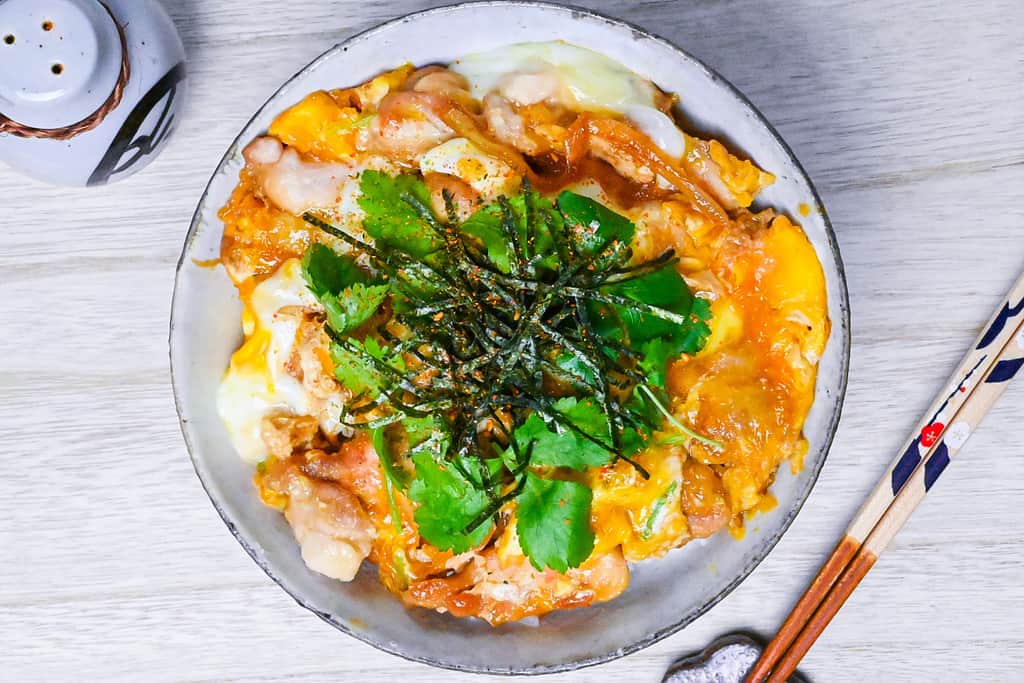

How I Developed This Recipe
When I set out to make this Oyakodon recipe, my goal was to capture the authenticity and quality you’d find in a dish served at a teishoku-restaurant.
The perfect balance between dashi and chicken flavor, complemented by soft, sweet onions and a gently cooked egg that cozily wraps around everything. It’s a dish that brings comfort and satisfaction with every bite.
I’d love for you to give it a try and see for yourself how simple and tasty homemade Japanese cuisine can be.
Ingredients & Substitution Ideas
- Boneless chicken thigh – This is most recommended, preferably with the skin on for better flavor and texture. However, if you prefer to use chicken breast, it will still work.
- Salt – for seasoning the chicken.
- All-purpose flour – for dredging the chicken. This helps the outside of the chicken become golden and lightly crispy but also carries the flavor, improving the taste of the dish as a whole.
- Cooking oil – I use white sesame oil for most of my day-to-day cooking, but you can use any kind of neutral flavored oil for this recipe.
- Yellow onion – adds a subtle and necessary sweetness to the dish. White onion is also fine.
- Mirin – When purchasing mirin, it is recommended to look for “hon mirin” (本みりん) for the best flavor. I recommend Hinode Hon Mirin as a high-quality and affordable option. See my 20 Most Useful Condiments and Seasonings for Japanese Cooking post for more recommendations.
- Light brown sugar – for additional sweetness and depth. You can use white sugar if you prefer.
- Dashi stock – This Japanese broth is the base of the cause. You can choose between a rich dashi made with dried bonito flakes and/or kelp, or plant-based dashi made with kelp and shiitake mushrooms. You could also use dashi granules or dashi packets for convenience.
- Chinese-style chicken bouillon powder – adds depth and umami. I always use Youki’s additive-free Garasupu.
- Soy sauce – If you are looking for something reasonably priced, you can’t go wrong with Kikkoman soy sauce. See my dedicated soy sauce article for more options.
- Eggs – for best results, I recommend letting the eggs reach room temperature before you start cooking. This will make them easier to whisk as well as help them cook faster and more evenly.
- Japanese wild parsley (mitsuba) or shredded nori seaweed (kizami nori) – optional topping ideas. Mainly for decoration but do add a little extra flavor to the dish.
- Japanese short-grain rice – I use koshi hikari rice and generally recommend using a rice cooker for easy and fail-free rice for donburi, however if you don’t have a rice cooker, check out my post on how to cook Japanese style rice on the stove here.
Curious about the exact brands and products that bring my recipes to life? Discover the brands and ingredients behind my recipes at the Sudachi Amazon Storefront. Explore my handpicked pantry essentials and find your next kitchen favorites!
Jump to Full Recipe Measurements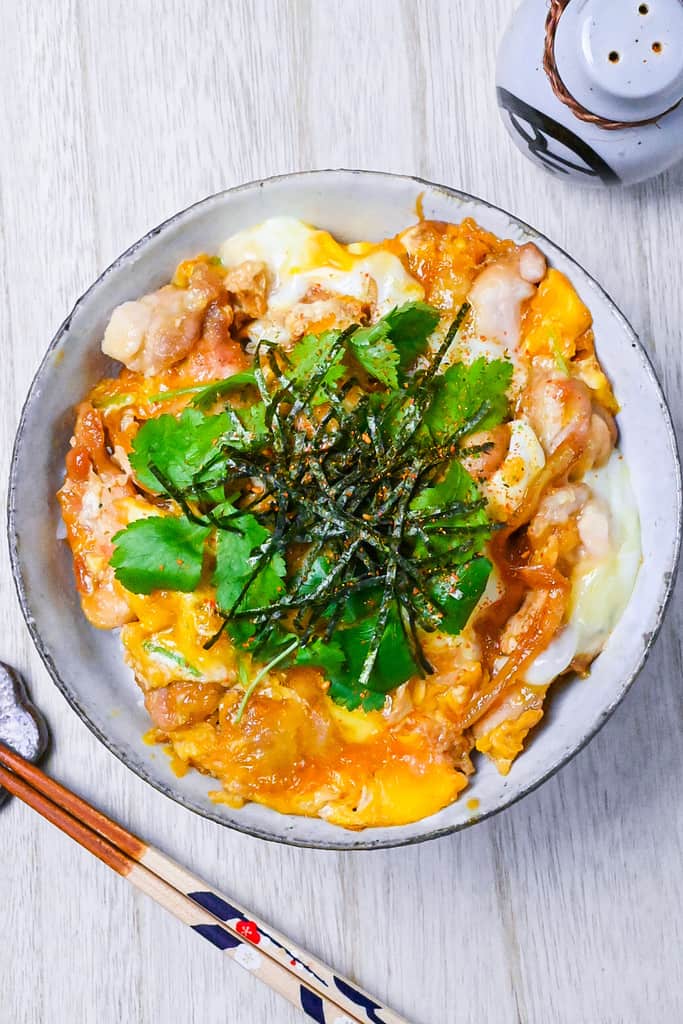
Visual Walkthrough & Tips
Here are my step-by-step instructions for how to make delicious and comforting Japanese Oyakodon at home. For ingredient quantities and simplified instructions, scroll down for the Printable Recipe Card below.
Cut the chicken thigh into bitesize pieces and season with a pinch of salt. Coat with a thin even layer of all-purpose flour.
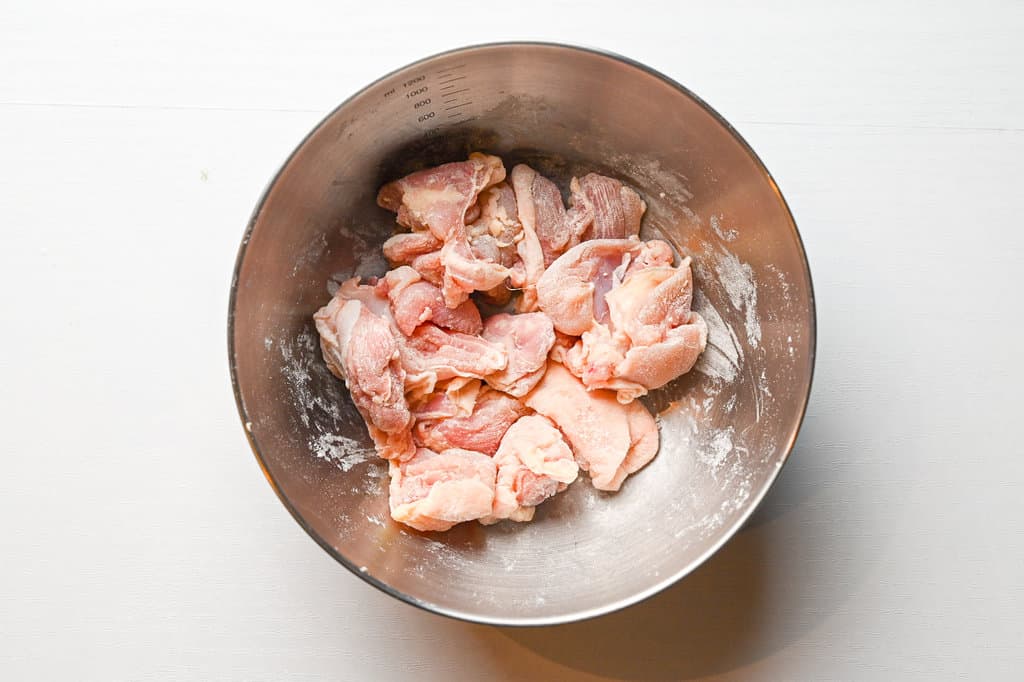
Heat a large frying pan on medium and add a drizzle of cooking oil. Once hot, lay the chicken pieces in a single layer in the pan with the skin side down. Fry until crispy and golden.
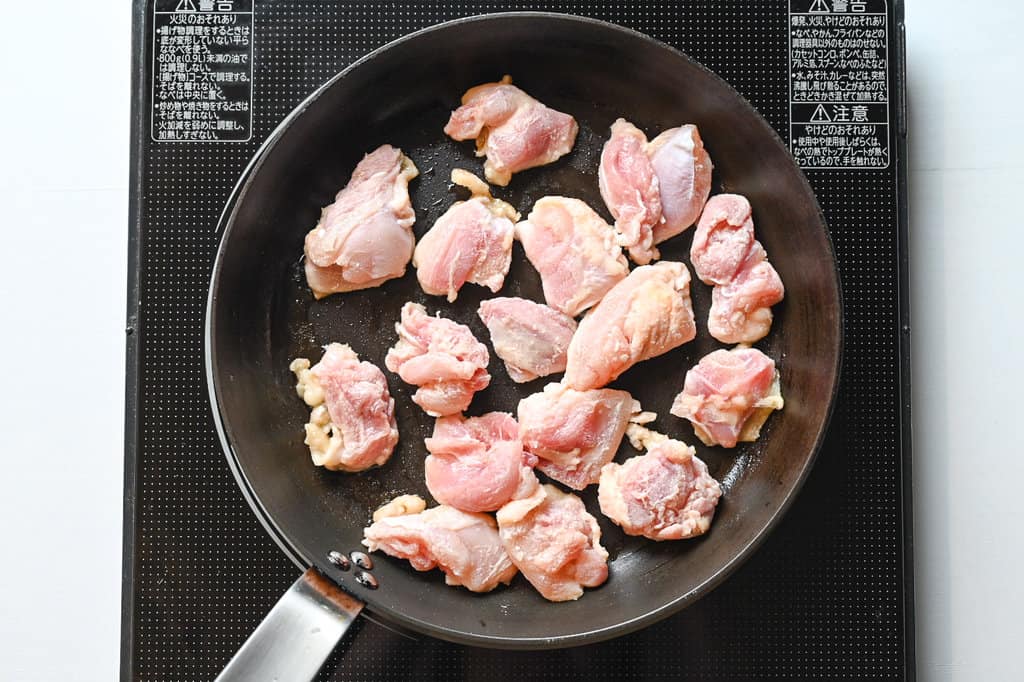
Flip and seal on the other side.
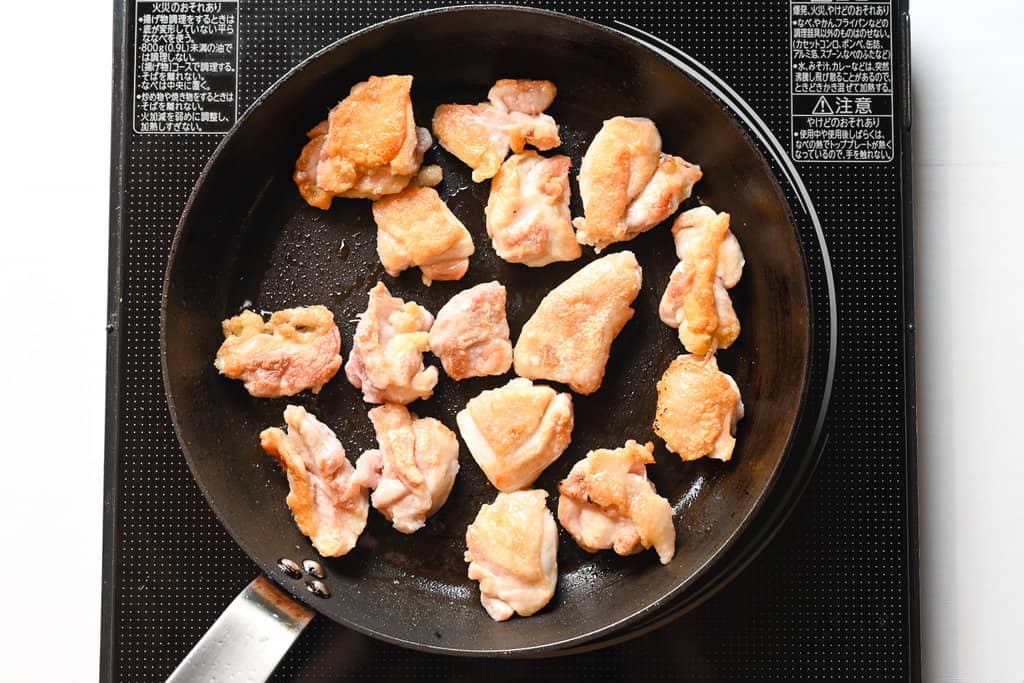
Once sealed, turn off the heat and set aside. (If you want to reuse the pan for the next step, feel free to transfer the chicken to a plate instead.)
Add dashi, mirin, light brown sugar and Chinese chicken bouillon powder to a pan and mix well. Add sliced onion to the broth and simmer over a medium heat until softened.
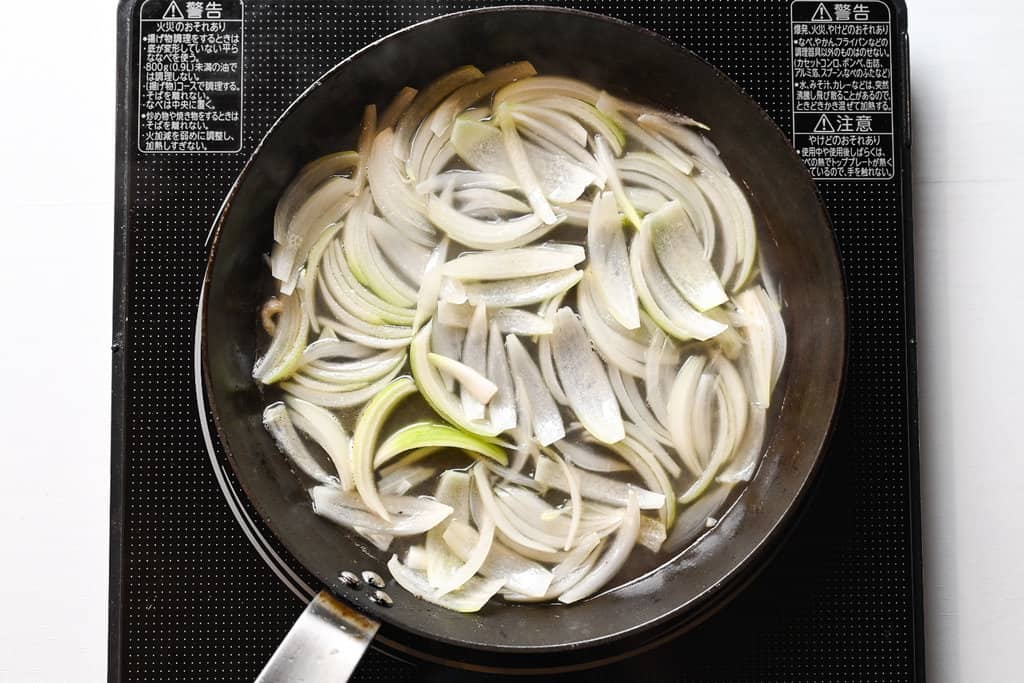
Cook the onions thoroughly to release their natural sweetness and highlight their soft, melt-in-mouth texture!
Once the onion has softened, pour soy sauce around the pan and place the chicken pieces back in.
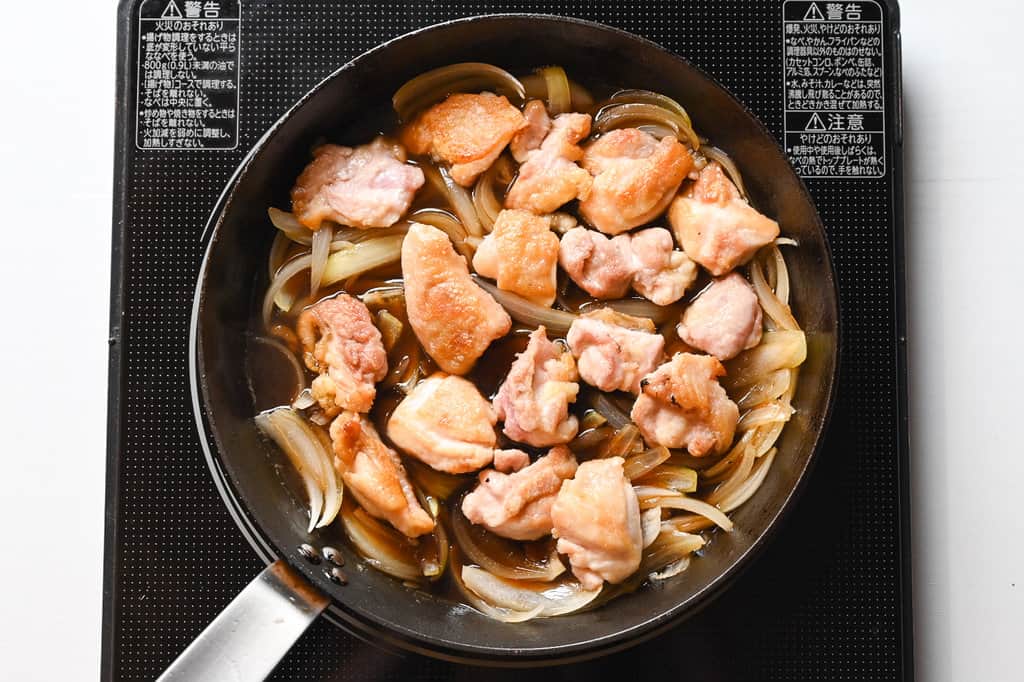
Separate 3 medium eggs into two bowls and whisk.
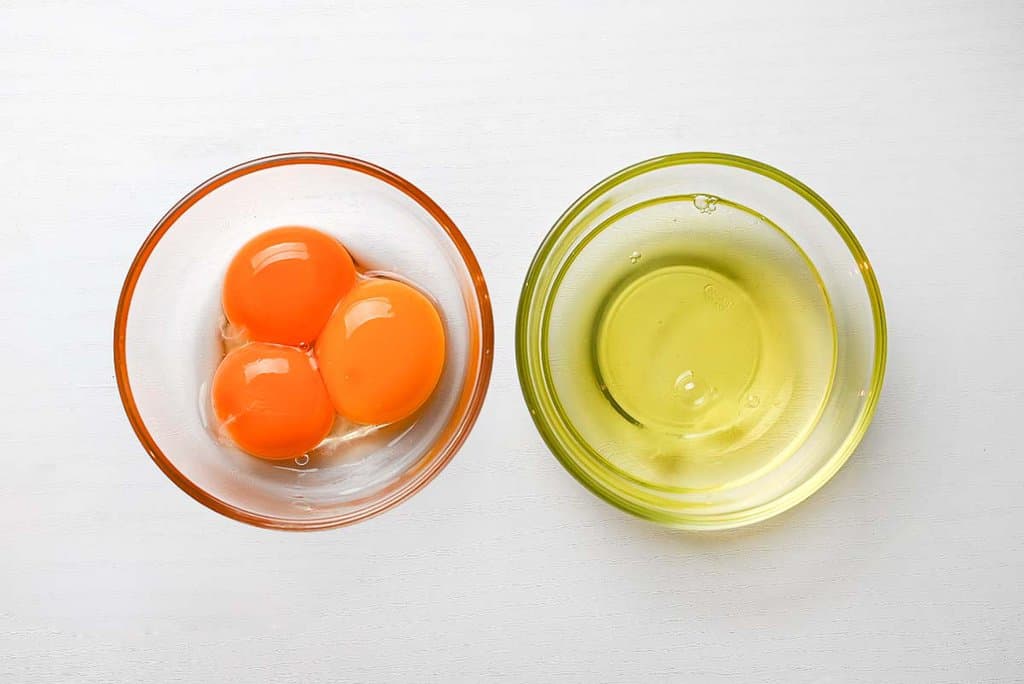
Egg yolks and egg whites have different coagulation temperatures (the temperature in which they firm up.) With that in mind, I add the egg white to the pan first, then whisk the yolk lightly and add it near the end. This also creates a better color on the top of the dish!
Pour the egg whites evenly around the pan. (Don’t add the yolks yet, set them aside for later.)
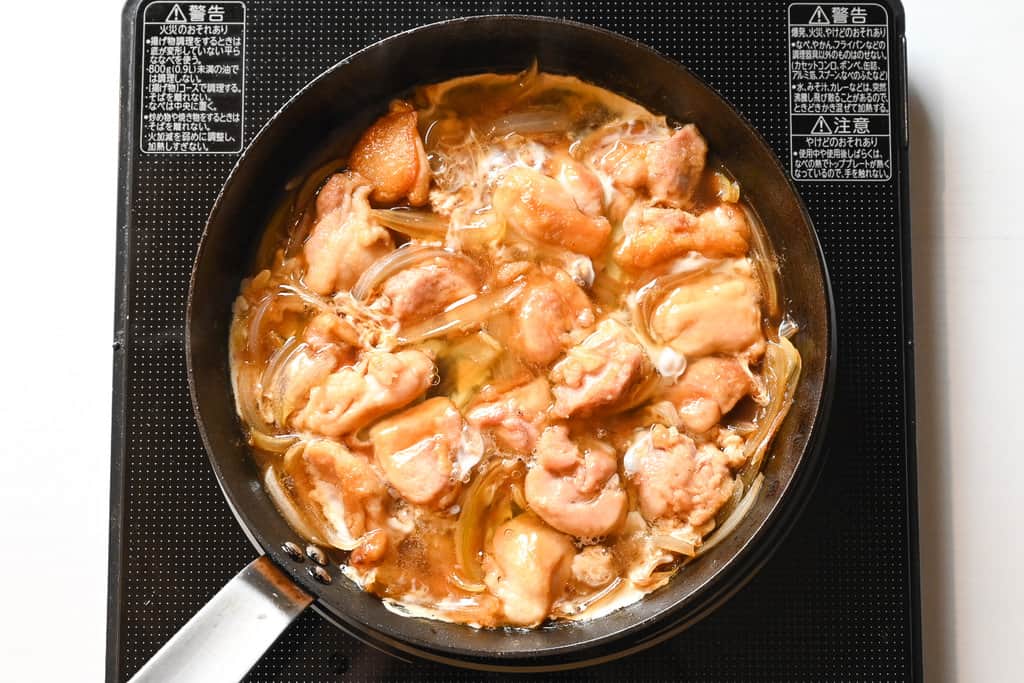
Add a lid and leave the egg whites to cook in the steam for about 1 minute.

Lightly whisk the egg yolks, then remove the lid from the pan and pour the yolks over the top.
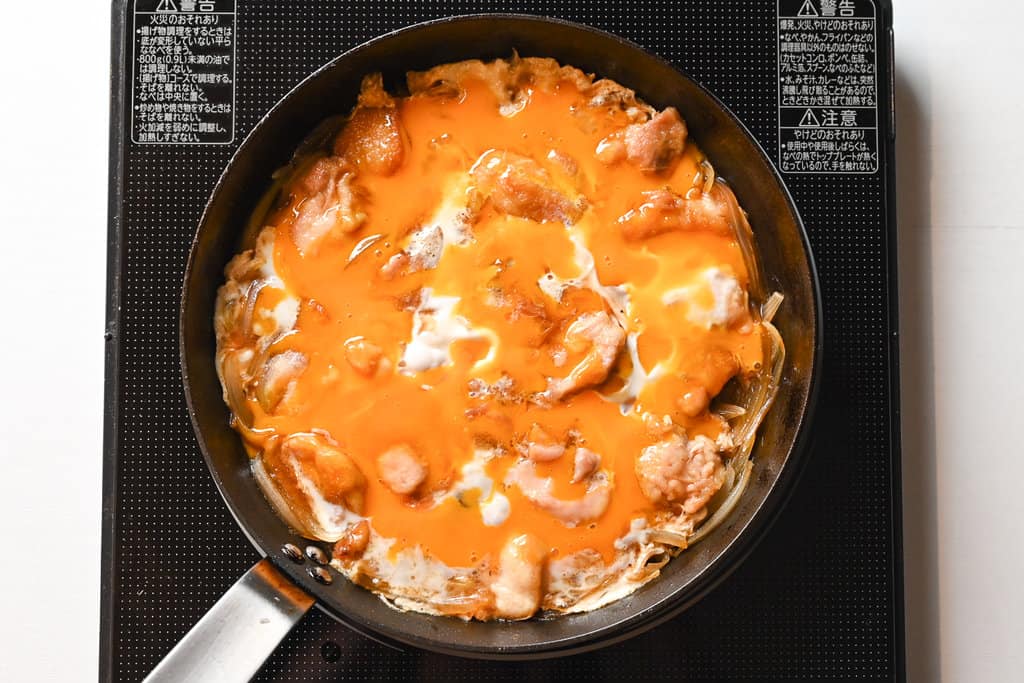
Place the lid back on and leave the egg to cook in the residual heat for a few minutes. Authentic Oyakodon should have a slightly runny egg but feel free to cook to your preferred doneness.
Divide your rice into bowls and the contents of the pan into equal portions. Place the chicken and egg on top of the rice. Try not to break the egg, I recommend using a spatula or something similar to transfer it.

Garnish with Japanese wild parsley and/or shredded nori (optional).
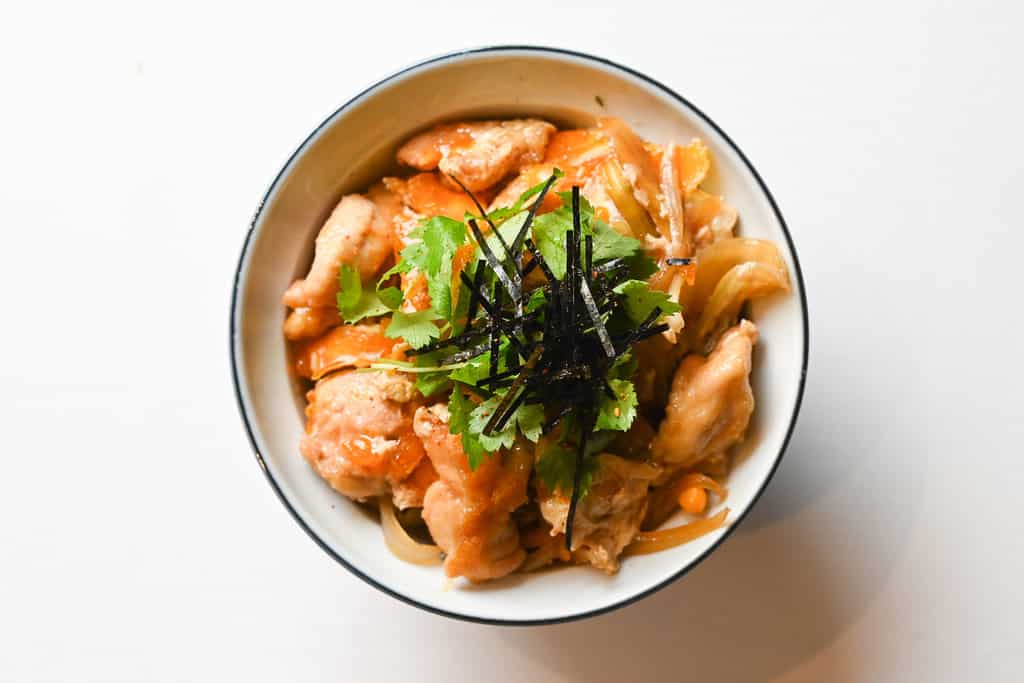
Enjoy!
Jump to Full Recipe MeasurementsTips & Tricks
Oyakodon is a quick and easy dish that it perfect for home-cooking. Although it’s a simple recipe, there are a few tips and tricks you can use to get it perfect every time!
- Dredge the chicken – coating the chicken with a thin layer of flour not only makes it beautifully crisp and golden, but it also helps absorb more flavor from the dashi and condiments.
- Cook the onions thoroughly – Make sure they’re soft and juicy before moving onto the next steps. Well-cooked onions have a better texture and release natural sweetness and depth into the broth.
- Room temperature eggs – Eggs fresh out of the fridge take longer to cook. By letting them reach room temperature beforehand, the cooking time will be reduced and they will cook more evenly.
- Separate the eggs – The yolks and whites have different coagulation temperatures, so adding them at different times ensures each part is cooked to perfection. Oyakodon is typically made with slightly runny egg, so adding the egg whites first ensures they are properly cooked with the yolks still slightly runny.
- Lightly whisk the eggs – If you whisk the eggs too much, they will lose their firmness and become too foamy. Use chopsticks or a fork to whisk them back and forth in the bowl a few times. That’s enough for Oyakodon!
- Don’t interfere with the eggs once they’re added – After pouring the beaten egg around the pan, try not to interfere with it. If you touch the egg before it hardens, it will mix with the dipping sauce and prevent the egg from binding properly.
FAQ
Although there are no official records, it is believed that Oyakodon appeared around the Meiji period (1868-1912) and originated from Tokyo or Osaka. The concept of the dish itself was born from pouring leftover chicken stew and raw egg over rice. It was a dish made up of leftovers, and these humble beginnings were the start of the delicious Oyakodon as we know it today!
Here’s an interesting fact: Oyakodon is one of the oldest donburi dishes, only second to Gyudon, which is made with beef.
Oyakodon and katsudon are two rice bowl dishes with a fair amount of similarities, so what is the difference? Well, in a nutshell, Oyakodon is made with pan-fried chicken and Katsudon is topped with deep fried pork cutlet. Even if the Katsudon were to be made with chicken cutlet instead, it would still be “katsudon” because of the use of “katsu” which means (deep-fried) cutlet in Japanese.
Despite this clear difference, the two dishes share many similarities, including the cooking broth, the simmering of onions, and the pouring of whisked egg at the end, which is then steamed for a short time until only just cooked.
I would say that Oyakodon is a little more accessible and suitable for everyday cooking since it doesn’t require deep frying, but if you have time, I highly recommend checking out my katsudon recipe!
Donburi dishes are always made with short-grain Japanese white rice. Most Japanese families have a rice cooker and that makes donburi recipes quick and easy, but you can also cook Japanese style rice on the stove.
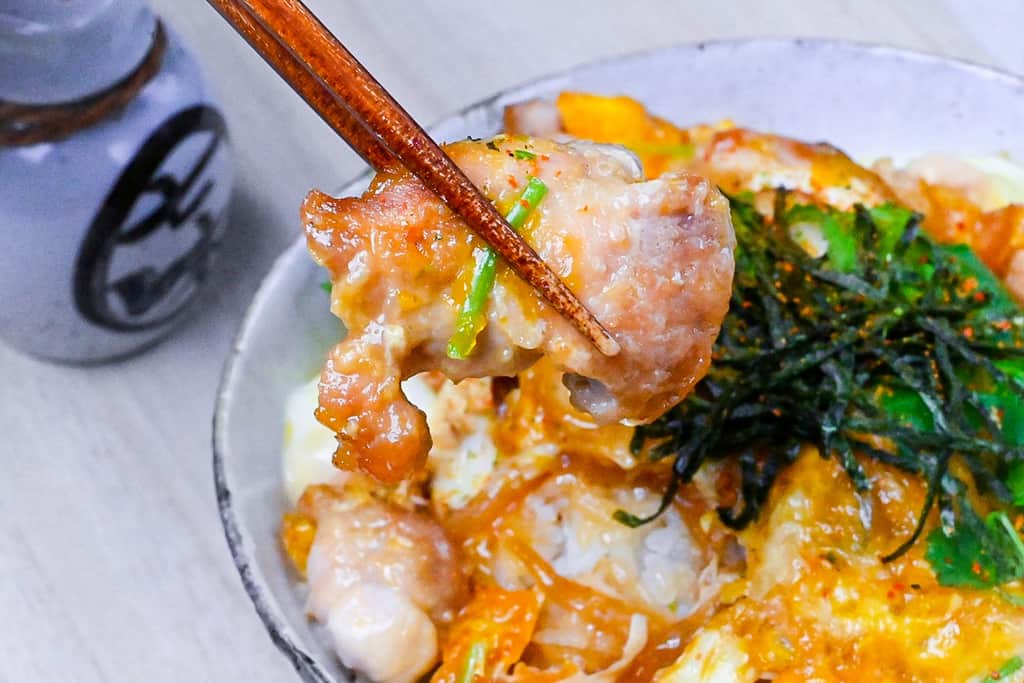
I hope you enjoy this Oyakodon recipe! If you try it out, I’d really appreciate it if you could spare a moment to let me know what you thought by giving a review and star rating in the comments below. It’s also helpful to share any adjustments you made to the recipe with our other readers. Thank you!
More Donburi Recipes
- “Karaage Don” Japanese Fried Chicken Donburi
- Sukiyaki Don (Sweet and Savory Simmered Beef Rice Bowl)
- Garlic Teriyaki Chicken bowl (Teriyaki chicken Donburi)
- Yakitori Donburi (Japanese Chicken Rice Bowl)
Want more inspiration? Explore my Donburi Recipe Roundup Post for a carefully selected collection of tasty recipe ideas to spark your next meal!
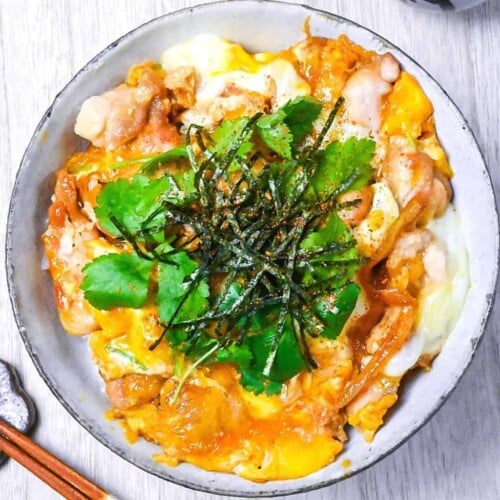
Oyakodon (Chicken and Egg Rice Bowl)
Equipment
Ingredients
- 200 g boneless chicken thigh skin-on, bitesize pieces
- 1 pinch salt
- 1 tbsp all-purpose flour
- 1 drizzle cooking oil
- 100 g yellow onion thin wedges
- 50 ml mirin
- 10 g light brown sugar
- 100 ml dashi stock
- 1 tsp Chinese-style chicken bouillon powder (granules)
- 2 tbsp soy sauce
- 3 egg room temperature
- 2 tbsp shredded sushi nori seaweed “kizami nori” optional, kizami nori
- 2 tbsp Japanese wild parsley (mitsuba) optional, mitsuba, or chopped green onion
- 2 portions cooked Japanese short-grain rice If you don't have a rice cooker, you can use my method to cook Japanese style rice on the stove.
Instructions
- Cut 200 g boneless chicken thigh into bitesize pieces and place them in a bowl. Add 1 pinch salt and 1 tbsp all-purpose flour, and mix thoroughly until make evenly coated.

- Heat a frying pan on medium and once hot, add 1 drizzle cooking oil. Place the chicken thigh pieces in the pan in a single layer with the skin side facing down.

- Fry the chicken until the skin becomes crispy and then flip over. Seal on the other side, then turn off the heat and set aside for now.

- Add 100 ml dashi stock, 50 ml mirin, 10 g light brown sugar, 1 tsp Chinese-style chicken bouillon powder (granules) to a pan and mix well. Place 100 g yellow onion in the broth and simmer over a medium heat until softened.

- Once softened, place the cooked chicken pieces in the pan and pour in 2 tbsp soy sauce.

- Separate 3 egg into two bowls and whisk.

- Pour the egg whites into the pan. (Do not add the yolks yet.)

- Place a lid on top and cook for 1 minute.

- Once 1 minute is up, drizzle the the lightly whisked egg yolks over the contents of the pan. Place the lid back on and turn off the heat. Allow the egg to cook in the residual heat until you're happy with the doneness of the egg. (Authentic oyakodon should have eggs that are only just cooked, slightly runny yolks are recommended.)

- Dish up 2 portions cooked Japanese short-grain rice and place the egg and chicken mixture on top.

- Garnish with 2 tbsp shredded sushi nori seaweed “kizami nori” and 2 tbsp Japanese wild parsley (mitsuba).

- Enjoy!
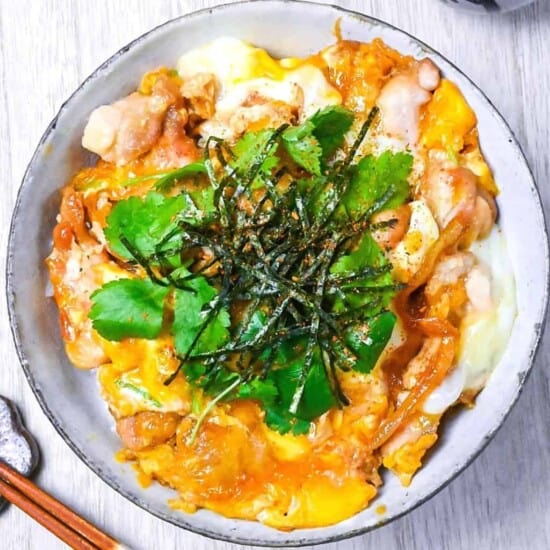



Best oyakodon recipe hands down. I’ve been scouring the internet for different kinds of oyakodon recipe. But this really recipe stands above the rest.
Can’t wait to cook more of your food!
Hi Joel,
Thank you so much for your kind words! It means a lot!
Yuto